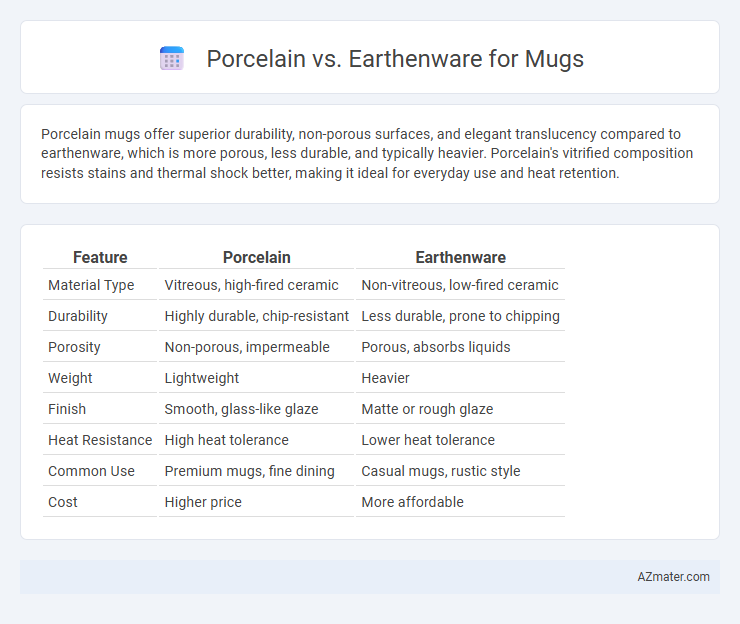Porcelain mugs offer superior durability, non-porous surfaces, and elegant translucency compared to earthenware, which is more porous, less durable, and typically heavier. Porcelain's vitrified composition resists stains and thermal shock better, making it ideal for everyday use and heat retention.
Table of Comparison
| Feature | Porcelain | Earthenware |
|---|---|---|
| Material Type | Vitreous, high-fired ceramic | Non-vitreous, low-fired ceramic |
| Durability | Highly durable, chip-resistant | Less durable, prone to chipping |
| Porosity | Non-porous, impermeable | Porous, absorbs liquids |
| Weight | Lightweight | Heavier |
| Finish | Smooth, glass-like glaze | Matte or rough glaze |
| Heat Resistance | High heat tolerance | Lower heat tolerance |
| Common Use | Premium mugs, fine dining | Casual mugs, rustic style |
| Cost | Higher price | More affordable |
Introduction to Porcelain and Earthenware Mugs
Porcelain mugs are crafted from highly refined clay fired at extremely high temperatures, resulting in a non-porous, durable, and translucent finish ideal for retaining heat. Earthenware mugs are made from natural clay fired at lower temperatures, giving them a more porous and rustic texture, often requiring a glaze to prevent leakage. Both types offer unique tactile and aesthetic qualities, with porcelain favored for elegance and heat retention, while earthenware provides a warm, handcrafted appearance.
Material Composition and Production Processes
Porcelain mugs are made from kaolin clay fired at high temperatures above 1,200degC, resulting in a dense, vitrified, and translucent material with high durability and resistance to chipping. Earthenware mugs consist of a porous clay body fired at lower temperatures between 1,000degC and 1,150degC, creating a more porous, softer material that is often glazed to improve water resistance and strength. The production process for porcelain involves precise refining and multiple firing stages, including glazing and sometimes a final high-temperature firing to achieve its characteristic whiteness and translucency, whereas earthenware undergoes a simpler firing process with lower temperature, resulting in a more rustic and less durable finish.
Durability and Strength Comparison
Porcelain mugs exhibit superior durability and strength compared to earthenware due to their higher firing temperature, resulting in a denser, non-porous structure that resists chipping and cracking under thermal stress. Earthenware mugs, fired at lower temperatures, possess a more porous and fragile composition, making them prone to breakage and surface wear over time. The enhanced vitrification process in porcelain ensures longevity and robustness, ideal for daily use and dishwasher safety.
Heat Retention and Insulation Properties
Porcelain mugs exhibit superior heat retention and insulation properties compared to earthenware due to their dense, vitrified structure, which minimizes heat loss and keeps beverages warm for extended periods. Earthenware mugs, being more porous and less dense, tend to lose heat faster and provide less effective insulation. For optimal warmth and durability in mugs, porcelain remains the preferred choice.
Weight and Handling Comfort
Porcelain mugs are significantly lighter than earthenware, offering enhanced handling comfort for prolonged use due to their fine, smooth texture. Earthenware mugs tend to be heavier and thicker, which can make them feel bulkier and less comfortable to hold over time. The lightweight nature of porcelain also contributes to better heat retention without compromising ease of grip, ideal for everyday drinking experiences.
Aesthetic Appeal and Design Options
Porcelain mugs offer a sleek, translucent appearance with smooth, glossy finishes that highlight intricate designs and vibrant colors. Earthenware mugs feature a rustic, matte texture and naturally warm tones, allowing for hand-painted patterns and organic, artisanal aesthetics. Both materials provide diverse design options, but porcelain emphasizes elegance and refinement, while earthenware conveys a handcrafted, earthy charm.
Porosity and Stain Resistance
Porcelain mugs feature a dense, non-porous structure that significantly reduces liquid absorption, offering superior stain resistance compared to earthenware. Earthenware has a more porous composition, making it more susceptible to stains and moisture retention over time. Choosing porcelain ensures easier cleaning and longer-lasting aesthetic appeal due to its low porosity and high stain resistance.
Microwave and Dishwasher Compatibility
Porcelain mugs are highly compatible with both microwaves and dishwashers due to their dense, non-porous structure that resists heat and moisture damage. Earthenware mugs, often more porous and less vitrified, may absorb moisture, making them less microwave-safe and more prone to chipping or cracking in dishwashers. Porcelain's superior durability ensures long-term use in high-temperature appliances, while earthenware requires more careful handling to maintain its integrity.
Cost and Availability
Porcelain mugs typically cost more due to their durability, fine quality, and complex manufacturing process, making them less affordable than earthenware options. Earthenware mugs are widely available and budget-friendly, often found in various retail stores and online marketplaces at lower prices. The cost difference reflects the materials' firing temperatures and strength, with porcelain being more resilient but less accessible in some markets.
Which Mug Material is Best for You?
Porcelain mugs are highly durable, non-porous, and resist chipping, making them ideal for everyday use and maintaining beverage temperature effectively. Earthenware mugs offer a rustic aesthetic and excellent heat retention but are more porous and prone to cracking or staining over time. Choosing between porcelain and earthenware depends on whether you prioritize durability and sleek design or a handcrafted, artisanal feel with potentially richer insulation.

Infographic: Porcelain vs Earthenware for Mug
 azmater.com
azmater.com